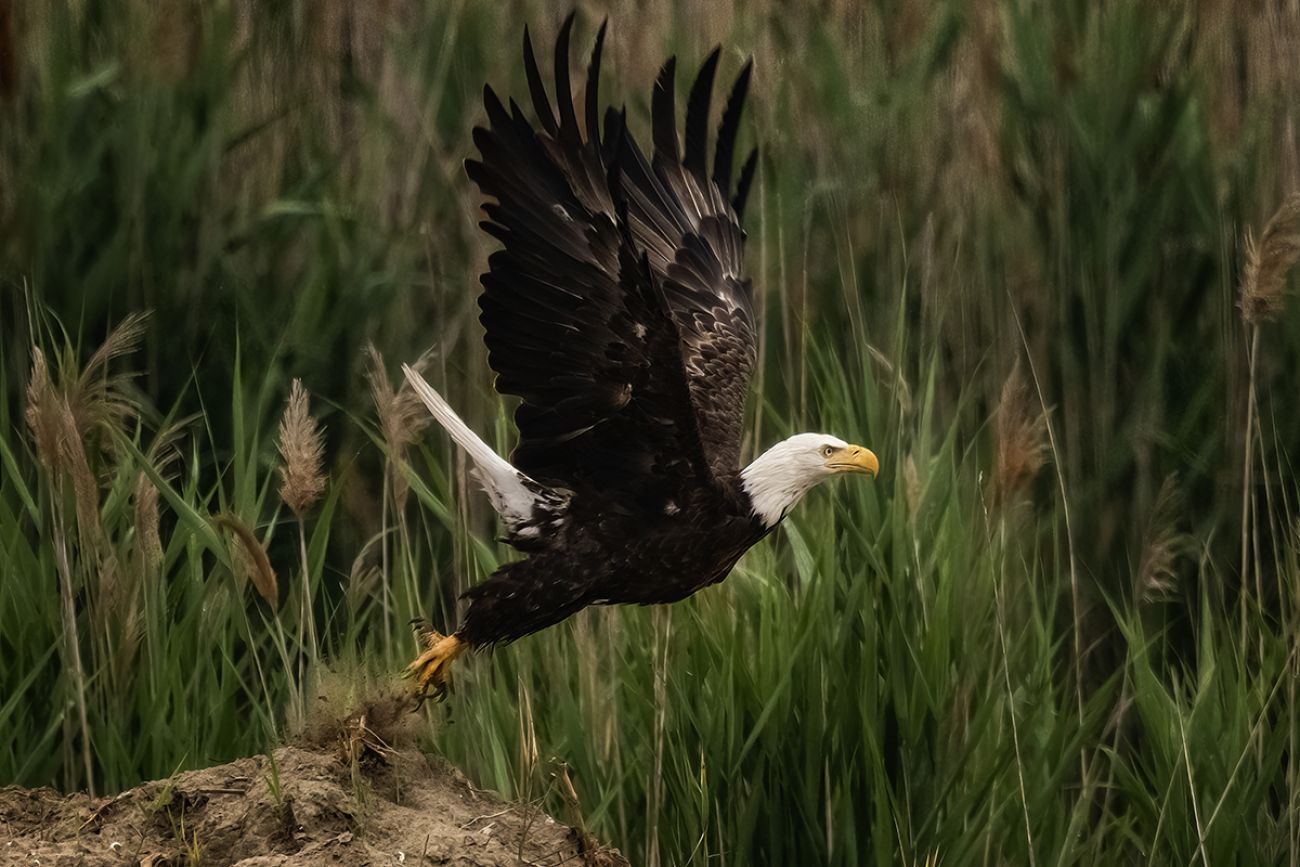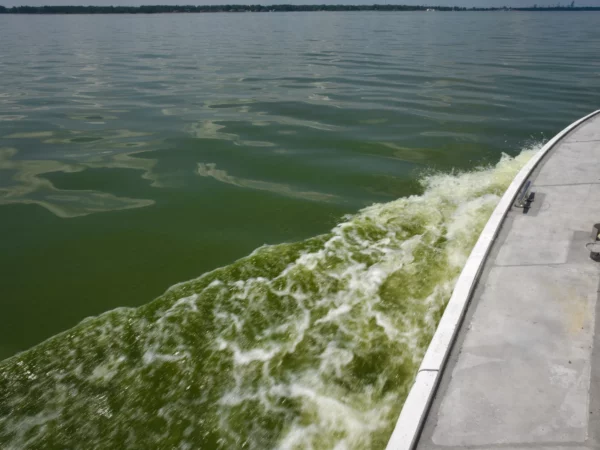
By Ashley Zhou, Bridge Michigan
The Great Lakes News Collaborative includes Bridge Michigan; Circle of Blue; Great Lakes Now at Detroit Public Television; and Michigan Radio, Michigan’s NPR News Leader; who work together to bring audiences news and information about the impact of climate change, pollution, and aging infrastructure on the Great Lakes and drinking water. This independent journalism is supported by the Charles Stewart Mott Foundation. Find all the work HERE.
- Michigan’s bald eagle population dipped to 52 breeding pairs in 1961, sparking fear of extinction from DDT and other threats
- The Michigan Bald Eagle Biomonitoring Project tracked the birds’ toxin loads, helping explain how chemicals harm eagles
- Eagle populations have slowly recovered, but the iconic bird still faces threats from lead poisoning and habitat loss
Bald eagles are hard to miss with their dark brown bodies, contrasting white heads and tails, bright yellow beak and 8-foot wingspan.
And it helps that their numbers are growing in Michigan — which professional photographer Stacy Williams has witnessed firsthand.
Thirteen years ago, Williams spotted one consistent pair of bald eagles on Harsens Island, the St. Clair County island where she lives. Last fall, she saw more than 13.
“It’s almost indescribable and thrilling to watch them grow in population,” Williams told Bridge Michigan. “It doesn’t matter if I have a camera or not, it is just awe-inspiring to watch them flourish.”
It’s a stunning success story for the country’s national bird, which was nearly wiped off the map by the 1960s after generations of human interference.
Six decades later, there are more than 300,000 bald eagles nationwide, and about 900 breeding pairs in Michigan, where the country’s most robust long-term tracking of toxicity levels in the birds played a key role in their comeback.
Once confined to just a few locations in the northern lower and Upper Peninsula, eagles are now present in nearly every corner of the state, including more urbanized areas like DTE’s Monroe Power Plant. Some parts of the Detroit River have also become eagle-watching hotspots.
But experts warn that lingering threats from lead bullets and habitat fragmentation remain barriers to a full recovery.

As of 2019, Michigan had more than 1,600 eagle nests and approximately 900 breeding pairs, compared to only 52 pairs in 1961. (Courtesy of Brett Billings)
A harsh population plunge
Though they’re a national symbol, bald eagles were once treated as vermin. They began disappearing in the 1800s, hunted out of the sky and pinched into ever-smaller territories as humans encroached on their nesting habitat.
By the mid-1900s, human-made chemicals presented another threat. Among them were dichlorodiphenyltrichloroethane (DDT) used to kill insects and an industrial chemical called polychlorinated biphenyls (PCBs) used as a coolant and lubricant.
“It was a real awakening with all of these chemicals and understanding what we were spraying in the environment,” said William Bowerman, a professor at the University of Maryland and co-author of the Michigan Bald Eagle Biomonitoring Project.
The Biomonitoring Project, a 57-year effort to keep tabs on levels of toxic chemicals in eagles’ systems, was one of the first to explore how the chemicals harm eagles. Scientists climbed to nests to collect annual samples from 1961 until 2018, creating one of the world’s largest long-term datasets.
Though DDT was relatively safe for humans, it was toxic to eagles and other bird species. It washed into waterways and tainted the fish eagles ate, causing them to lay eggs with paper-thin shells, or sometimes no shell at all. Contact with PCBs caused embryo mortality and birth defects.
The project’s early research helped reveal massive toxicity levels in the bald eagles near the Great Lakes — six times that of those in other regions— which correlated with lower birth rates. Levels of DDT and PCBs declined in bald eagles after the substances were finally banned in the U.S. in the 1970s.
Michigan’s eagle population bottomed out at 52 breeding pairs by 1961 — about one pair for every 1,087 square miles of land. Nationally, the loss was even worse, with 417 recorded pairs across the lower 48 states.
Michigan became the first state to ban DDT in 1969. A national ban followed three years later. By 1978, the U.S. Fish and Wildlife Service (USFWS) listed bald eagles as endangered in the majority of the country and threatened in a handful of other states, including Michigan.
That led to new protections for the birds and helped free up resources to restore their habitat. Through the Great Lakes Water Quality Agreement, the U.S. and Canada set a goal to cleanse the Great Lakes of toxic substances in part by establishing 43 Areas of Concern for cleanup.
Many sites have languished with no comprehensive cleanup, but a new influx of federal money promises to kickstart cleanup. Areas targeted for renewed effort include the Detroit River, where eagles now enjoy cleaner water and better habitat thanks to land conservation efforts like the creation of the Detroit River International Wildlife Refuge.
And over the years, declining levels of DDT in the environment have allowed eagles to rebound.
The birds were officially removed from the threatened and endangered species list in 2007. At the latest count in 2019, Michigan had an estimated 900 breeding pairs, a seventeen-fold increase from eagles’ lowest point.
Current and future threats
With eagle populations now in much better shape, constant monitoring is no longer necessary.
Today, the federal government tracks eagle populations every six years, said Mags Rheude, a regional eagle biologist at the USFWS. Deeper health check-ups are limited to smaller segments of the populations living in environmentally degraded areas, said Chris Mensing, a USFWS fish and wildlife biologist.
But while the population is growing, human activities remain a barrier to complete recovery: notably, the continued use of lead bullets and fishing tackle, which poison eagles by riddling their prey with shrapnel and sinkers.
Today, vehicle collisions are eagles’ leading cause of death. Lead poisoning is next in line, with one study last year finding 47 percent of bald eagles had signs of chronic poisoning.
Rheude said lead poisoning also plays a role in the scourge of eagles being hit by cars because it hinders the birds’ ability to hunt and fly. As a result, they are more likely to target roadkill and less likely to avoid an oncoming vehicle.
“There’s a lot of alternatives now for lead, so we can move that way,” Bowerman said.
But a ban on lead bullets remains elusive, even as wildlife advocates push for change. The federal government banned lead bullets for waterfowl hunting in 1991 but lead bullets and tackle are still allowed in hunting other animals in Michigan. The Department of Natural Resources provides information that educates hunters and anglers about non-toxic alternatives such as copper ammunition or steel sinkers.
California was the first state to fully ban the use of lead ammo in 2019, and several other states have instituted partial bans. Some conservation groups think Michigan should follow suit. The Michigan United Conservation Clubs, a group that advocates for hunters and anglers, passed a resolution in 2020 that encourages the use of non-lead alternative ammunition and hunting goods.
Mensing said Michigan eagles “appear to be reproducing at high enough rates to mitigate the impacts from lead.”
“However,” he said, “eagle reproductive rates are dynamic in response to myriad environmental factors so we can’t solely look at past history to predict the future of eagle population.”
Catch more news at Great Lakes Now:
Michigan under statewide advisory as Canada wildfire smoke hits Midwest
Nessel: $10B PFAS settlement with 3M doesn’t resolve Michigan’s claims
Featured image: In July, a bald eagle took flight off from Harsens Island in St. Clair County, a rare sighting during this season, said Stacy Williams, owner of Harsens Island Photography. (Courtesy of Harsens Island Photography, LLC)




